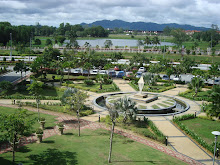

Photos from Genting Highland's pond
Koi a type of fish that can really take your stress away.Whenever you stressed up or sad just take a walk around a pond which is fill with these fishes. I can bet that you'll be smiling in no time. Trust me ok?
Japanese Carp or better known as Koi are actually from Japan. A little back ground on these colorful fishes. Koi breeding originated in the 18th century in the Niigata prefecture of Japan.

In the olden, days koi can be found on the rice field and thanks to the farmers they are now among the most notable ornamental fish around the World. Koi are normally distinguished by their coloration, patterning, and scalation. Among the major colors are white, black, red, yellow, blue, and cream.
Here is an acticle i would like you guys to read.
Wild Common Carp in Japan Under Threat
JAPAN - Scientists from Japan have discovered the introduction of domesticated strains of carp from Eurasia are destroying the wild carp (Cyprinus carpio)populations.
The scientists, K. Mabichi, H. Senou and M. Nishida from the University of Tokyo and the Kanagawa Prefecture Museum of Natural History, looked at the mitochondrial DNA sequences from 116 wild carp from 11 different areas in Japan.
THe results of the survey, Mitochondrial DNA analysis reveals cryptic largescale invasion of non-native genotypes of common carp ( Cyprinus carpio) in Japan, have been published in a recent issue of the journal Molecular Ecology 17, 796-809.

DNA
Of total 28 haplotypes identified, the authors believe 19 haplotypes are of Japanese native and the rest are non-native domesticated strains. Introduced animals are likely from China and Europe.
The study also revealed that almost half or more of the haplotypes in all of the locations studied originated from domesticated strains introduced from Eurasia.
Mitochondrial DNA is maternally inherited and provides no information with respect to hybridisation between native and non-native fish. However, evidence of hybridisation between native and introduced strains of common carp has been reported for German and Uzbekistan populations and "thus, it is reasonable to assume that the native and non-native domesticated strains also have hybridised in Japan. The extent to which such hybridisations have occurred should be examined immediately. Until then, we cannot eliminate the possibility that no genetically pure native strains remain," says the report.
The study reconfirmed the fact that Japanese common carp is the "most basal strain of the species identified to date" and deserves conservation attention.
TheFishSite News Desk February 26, 2008

It's such a pity that in the wild these beautiful fishes are slowing dying out. The work of us "Humans" again. Please play your part to save our environment or else there won't be any left for our children...


HI, we are Luca and Chiara, two italian teenagers.
ReplyDeleteWe are writing to you, beacause we are opened a new about trips, excursions, holidays, and travells, would you like to help us?
If you want come to our blog, this is the link: http://noingro.blogspot.com
and leave a comment and and to the sondage!
Thank a lot
Chiara and Luca
Hi Chiara and Luca, thanks for your comment. I've visited your blog and I Love the pictures. What can i do to help you guys??
ReplyDelete